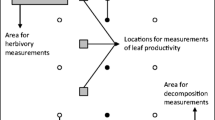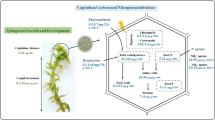Abstract
Increased N deposition in Europe has affected mire ecosystems. However, knowledge on the physiological responses is poor. We measured photosynthetic responses to increasing N deposition in two peatmoss species (Sphagnum balticum and Sphagnum fuscum) from a 3-year, north–south transplant experiment in northern Europe, covering a latitudinal N deposition gradient ranging from 0.28 g N m−2 year−1 in the north, to 1.49 g N m−2 year−1 in the south. The maximum photosynthetic rate (NPmax) increased southwards, and was mainly explained by tissue N concentration, secondly by allocation of N to the photosynthesis, and to a lesser degree by modified photosystem II activity (variable fluorescence/maximum fluorescence yield). Although climatic factors may have contributed, these results were most likely attributable to an increase in N deposition southwards. For S. fuscum, photosynthetic rate continued to increase up to a deposition level of 1.49 g N m−2 year−1, but for S. balticum it seemed to level out at 1.14 g N m−2 year−1. The results for S. balticum suggested that transplants from different origin (with low or intermediate N deposition) respond differently to high N deposition. This indicates that Sphagnum species may be able to adapt or physiologically adjust to high N deposition. Our results also suggest that S. balticum might be more sensitive to N deposition than S. fuscum. Surprisingly, NPmax was not (S. balticum), or only weakly (S. fuscum) correlated with biomass production, indicating that production is to a great extent is governed by factors other than the photosynthetic capacity.


Similar content being viewed by others
References
Adams WW, Demmig-Adams B (2004) Chlorophyll fluorescence as a tool to monitor plant response to the environment. In: Papageorgiou GC, Govindjee (eds) Chlorophyll a fluorescence—a signature of photosynthesis. Springer, Dordrecht, pp 583–604
Aerts R, Wallén B, Malmer N (1992) Growth-limiting nutrients in Sphagnum-dominated bogs subject to low and high atmospheric nitrogen supply. J Ecol 80:131–140
Alpert P (1984) Analysis of chlorophyll content in mosses through extraction in DMSO. Bryologist 87:363–365
Arróniz-Crespo M, Leake JR, Horton P, Phoenix GK (2008) Bryophyte physiological responses to, and recovery from, long-term nitrogen deposition and phosphorus fertilisation in acidic grassland. New Phytol 180:864–874
Austin KA, Wieder RK (1987) Effects of elevated H+, SO4 2−, NO3 −, and NH4 + in simulated acid precipitation on the growth and chlorophyll content of 3 North American Sphagnum species. Bryologist 90:221–229
Baxter R, Emes MJ, Lee JA (1989) Effects of the bisulphite ion on growth and photosynthesis in Sphagnum cuspidatum Hoffm. New Phytol 111:457–462
Baxter R, Emes MJ, Lee JA (1992) Effects of an experimentally applied increase in ammonium on growth and amino-acid metabolism of Sphagnum cuspidatum Ehrh. ex. Hoffm. from differently polluted areas. New Phytol 120:265–274
Berendse F, van Breemen N, Rydin H, Buttler A, Heijmans M, Hoosbeek MR, Lee JA, Mitchell E, Saarinen T, Vasander H, Wallén B (2001) Raised atmospheric CO2 levels and increased N deposition cause shifts in plant species composition and production in Sphagnum bogs. Global Change Biol 7:591–598
Bragazza L, Tahvanainen T, Kutnar L, Rydin H, Limpens J, Hájek M, Grosvernier P, Hájek T, Hajkova P, Hansen I, Iacumin P, Gerdol R (2004) Nutritional constraints in ombrotrophic Sphagnum plants under increasing atmospheric nitrogen deposition in Europe. New Phytol 163:609–616
Bragazza L, Freeman C, Jones T, Rydin H, Limpens J, Fenner N, Ellis T, Gerdol R, Hajek M, Lacumin P, Kutnar L, Tahvanainen T, Toberman H (2006) Atmospheric nitrogen deposition promotes carbon loss from peat bogs. Proc Natl Acad Sci USA 103:19386–19389
Bubier JL, Moore TR, Bledzki LA (2007) Effects of nutrient addition on vegetation and carbon cycling in an ombrotrophic bog. Global Change Biol 13:1168–1186
Clymo RS (1970) The growth of Sphagnum: methods of measurement. J Ecol 58:13–49
Csintalan Z, Proctor MCF, Tuba Z (1999) Chlorophyll fluorescence during drying and rehydration in the mosses Rhytidiadelphus loreus (Hedw.) Warnst., Anomodon viticulosus (Hedw.) Hook. & Tayl. and Grimmia pulvinata (Hedw.) Sm. Ann Bot 84:235–244
Daniels RE, Eddy A (1990) Handbook of European Sphagna. Institute of Terrestrial Ecology, Abbots Ripton
Deltoro VI, Calatayud A, Gimeno C, Abadia A, Barreno E (1998) Changes in chlorophyll a fluorescence, photosynthetic CO2 assimilation and xanthophyll cycle interconversions during dehydration in desiccation-tolerant and intolerant liverworts. Planta 207:224–228
Evans JR (1989) Photosynthesis and nitrogen relationships in leaves of C-3 plants. Oecologia 78:9–19
Gaberscik A, Martincic A (1987) Seasonal dynamics of net photosynthesis and productivity of Sphagnum papillosum. Lindbergia 13:105–110
Gerdol R, Bonora A, Gualandri R, Pancaldi S (1996) CO2 exchange, photosynthetic pigment composition, and cell ultrastructure of Sphagnum mosses during dehydration and subsequent rehydration. Can J Bot 74:726–734
Gerdol R, Petraglia A, Bragazza L, Iacumin P, Brancaleoni L (2007) Nitrogen deposition interacts with climate in affecting production and decomposition rates in Sphagnum mosses. Global Change Biol 13:1810–1821
Glime JM (2007) Bryophyte ecology. Ebook sponsored by Michigan Technological University and the International Association of Bryologists. http://www.bryoecol.mtu.edu/. Accessed 1 Oct 2007
Gunnarsson U (2005) Global patterns of Sphagnum productivity. J Bryol 27:267–277
Gunnarsson U, Rydin H (2000) Nitrogen fertilisation reduces Sphagnum production in Swedish bogs. New Phytol 147:527–537
Gunnarsson U, Sjörs H, Rydin H (2000) Diversity and pH changes after 50 years on the boreal mire Skattlösbergs Stormosse, Central Sweden. J Veg Sci 11:277–286
Gunnarsson U, Malmer N, Rydin H (2002) Dynamics or constancy in Sphagnum dominated mire ecosystems? A 40-year study. Ecography 25:685–704
Gunnarsson U, Granberg G, Nilsson M (2004) Growth, production and interspecific competition in Sphagnum: effects of temperature, nitrogen and sulphur treatments on a boreal mire. New Phytol 163:349–359
Hajek T, Beckett R (2008) Effect of water content components on desiccation and recovery in Sphagnum mosses. Ann Bot 101:165–173
Harley PC, Tenhunen JD, Murray KJ, Beyers J (1989) Irradiance and temperature effects on photosynthesis of tussock tundra Sphagnum mosses from the foothills of the Philip Smith Mountains, Alaska. Oecologia 79:251–259
Hikosaka K, Kato MC, Hirose T (2004) Photosynthetic rates and partitioning of absorbed light energy in photoinhibited leaves. Physiol Plant 121:699–708
Koranda M, Kerschbaum S, Wanek W, Zechmeister H, Richter A (2007) Physiological responses of bryophytes Thuidium tamariscinum and Hylocomium splendens to increased nitrogen deposition. Ann Bot 99:161–169
Lamers LPM, Bobbink R, Roelofs JGM (2000) Natural nitrogen filter fails in polluted raised bogs. Global Change Biol 6:583–586
Lee JA, Baxter R, Emes MJ (1990) Responses of Sphagnum species to atmospheric nitrogen and sulphur deposition. Bot J Linn Soc 104:255–265
Li Y, Vitt DH (1997) Patterns of retention and utilization of aerially deposited nitrogen in boreal peatlands. Ecoscience 4:106–116
Limpens J, Berendse F (2003) Growth reduction of Sphagnum magellanicum subjected to high nitrogen deposition: the role of amino acid nitrogen concentration. Oecologia 135:339–345
Limpens J, Berendse F, Klees H (2003a) N deposition affects N availability in interstitial water, growth of Sphagnum and invasion of vascular plants in bog vegetation. New Phytol 157:339–347
Limpens J, Raymakers JTAG, Baar J, Berendse F, Zijlstra JD (2003b) The interaction between epiphytic algae, a parasitic fungus and Sphagnum as affected by N and P. Oikos 103:59–68
Manning P, Newington JE, Robson HR, Saunders M, Eggers T, Bradford MA, Bardgett RD, Bonkowski M, Ellis RJ, Gange AC, Grayston SJ, Kandeler E, Marhan S, Reid E, Tscherko D, Godfray HCJ, Rees M (2006) Decoupling the direct and indirect effects of nitrogen deposition on ecosystem function. Ecol Lett 9:1015–1024
Marschall M, Proctor MCF (2004) Are bryophytes shade plants? Photosynthetic light responses and proportions of chlorophyll a, chlorophyll b and total carotenoids. Ann Bot 94:593–603
Maxwell K, Johnson GN (2000) Chlorophyll fluorescence—a practical guide. J Exp Bot 51:659–668
Murray KJ, Tenhunen JD, Nowak RS (1993) Photoinhibition as a control on photosynthesis and production of Sphagnum mosses. Oecologia 96:200–207
Niyogi KK (1999) Photoprotection revisited: genetic and molecular approaches. Annu Rev Plant Physiol Plant Mol Biol 50:333–359
Nordin A, Gunnarsson U (2000) Amino acid accumulation and growth of Sphagnum under different levels of N deposition. Ecoscience 7:474–480
Nordin A, Strengbom J, Witzell J, Nasholm T, Ericson L (2005) Nitrogen deposition and the biodiversity of boreal forests: implications for the nitrogen critical load. Ambio 34:20–24
Palmqvist K, Sundberg B (2001) Characterising photosynthesis and respiration in freshly isolated or cultured lichen photobionts. In: Kranner I, Beckett R, Varma A (eds) Protocols in lichenology—culturing, biochemistry, physiology and use in biomonitoring. Springer, Berlin, pp 152–181
Persson C, Ressner E, Klein T (2004) Nationell miljöövervakning—MATCH—Sverige modellen Metod- och resultatsammanställning för åren 1999–2002 samt diskussion av osäkerheter, trender och miljömål. Meteorologi report 113. Swedish Meteorological and Hydrological Institute (SMHI), Norrköping
Potter L, Foot JP, Caporn SJM, Lee JA (1996) Responses of four Sphagnum species to acute ozone fumigation. J Bryol 19:19–32
Press MC, Woodin SJ, Lee JA (1986) The potential importance of an increased atmospheric nitrogen supply to the growth of ombrotrophic Sphagnum species. New Phytol 103:45–55
Raeymaekers G, Longwith JE (1987) The use of DMSO as a solvent to extract chlorophyll from mosses. In: Pocs T, Simon T, Tuba Z, Podani J (eds) Proceedings of the IAB Conference of Bryoecology, parts A and B, Kiado, Budapest, Hungary. pp 151–164
Rudolph H, Voigt JU (1986) Effects of NH4 +-N and NO3 −-N on growth and metabolism of Sphagnum magellanicum. Physiol Plant 66:339–343
Rudolph H, Hohlfeld J, Jacubowski S, von der Lage P, Matlok H, Schmidt H (1993) Nitrogen metabolism of Sphagnum. Adv Bryol 5:79–105
Rydin H, Jeglum JK (2006) The biology of Peatlands. Oxford University Press, New York
Schipperges B, Rydin H (1998) Response of photosynthesis of Sphagnum species from contrasting microhabitats to tissue water content and repeated desiccation. New Phytol 140:677–684
Simola LK (1975) The effect of several protein amino acids and some inorganic nitrogen sources on the growth of Sphagnum nemoreum. Physiol Plant 35:194–199
Stevens CJ, Dise NB, Mountford JO, Gowing DJ (2004) Impact of nitrogen deposition on the species richness of grasslands. Science 303:1876–1879
Strengbom J, Nordin A, Nasholm T, Ericson L (2002) Parasitic fungus mediates change in nitrogen-exposed boreal forest vegetation. J Ecol 90:61–67
van der Heijden E, Verbeek SK, Kuiper PJC (2000) Elevated atmospheric CO2 and increased nitrogen deposition: effects on C and N metabolism and growth of the peat moss Sphagnum recurvum P. Beauv. var. mucronatum. (Russ.) Warnst. Global Change Biol 6:201–212
Vergeer P, van den Bergv LLJ, Bulling MT, Ashmore MR, Kunin WE (2008) Geographical variation in the response to nitrogen deposition in Arabidopsis lyrata petraea. New Phytol 179:129–141
Vitt DH, Wieder K, Halsey LA, Turetsky M (2003) Response of Sphagnum fuscum to nitrogen deposition: a case study of ombrogenous peatlands in Alberta, Canada. Bryologist 106:235–245
Weih M, Rönnberg-Wästljung A-C (2007) Shoot biomass growth is related to the vertical leaf nitrogen gradient in Salix canopies. Tree Physiol 27:1551–1559
Wellburn AR (1994) The spectral determination of chlorophyll-a and chlorophhyll-b, as well as total carotenoids, using various solvents with spectrophotometers of different resolution. J Plant Physiol 144:307–313
Wiedermann MM, Nordin A, Gunnarsson U, Nilsson MB, Ericson L (2007) Global change shifts vegetation and plant-parasite interactions in a boreal mire. Ecology 88:454–464
Wiedermann MM, Gunnarsson U, Ericson L, Nordin A (2008) Ecophysiological adjustment of two Sphagnum species in response to anthropogenic N deposition. New Phytol 181:208–217
Acknowledgments
We thank Michael Proctor and Kouki Hikosaka for comments on the manuscript. Funding for this project was provided by Formas, VR and the Netherlands Organization for Scientific Research (NWO-project 110015-01). The work conforms to the legal requirements of the countries in which it was carried out, including those relating to conservation and welfare.
Author information
Authors and Affiliations
Corresponding author
Additional information
Communicated by Kouki Hikosaka.
Rights and permissions
About this article
Cite this article
Granath, G., Strengbom, J., Breeuwer, A. et al. Photosynthetic performance in Sphagnum transplanted along a latitudinal nitrogen deposition gradient. Oecologia 159, 705–715 (2009). https://doi.org/10.1007/s00442-008-1261-1
Received:
Accepted:
Published:
Issue Date:
DOI: https://doi.org/10.1007/s00442-008-1261-1




